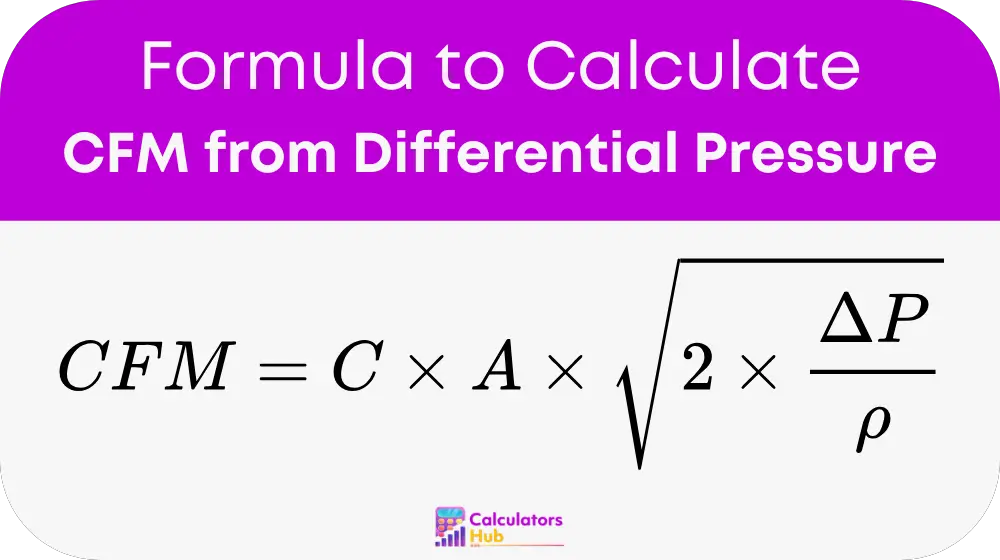The CFM (Cubic Feet per Minute) from Differential Pressure Calculator is a tool designed to measure airflow through an orifice or vent based on differential pressure. This measurement is particularly helpful in HVAC systems, industrial ventilation, and fluid dynamics applications where knowing the flow rate of air or gas is essential for system efficiency, compliance, and safety.
Using differential pressure to calculate CFM is a common method because it provides accurate flow measurements. By measuring the pressure difference across an orifice, you can estimate how much air or gas is flowing through, allowing operators to optimize ventilation rates, assess HVAC performance, and even calibrate equipment in industrial settings.
Formula of CFM from Differential Pressure Calculator
To calculate CFM from differential pressure, use the following formula:

Where:
- CFM is the volumetric flow rate in cubic feet per minute.
- C is the discharge coefficient, a dimensionless number that varies based on the orifice design (typically between 0.6 and 0.8).
- A is the cross-sectional area of the orifice in square feet.
- ΔP is the differential pressure across the orifice in pounds per square foot (psf).
- ρ is the air density in pounds per cubic foot (lb/ft³).
Steps to Calculate CFM
- Calculate the Orifice Area (A):
- If you know the orifice diameter (D) in inches, first convert it to feet by dividing by 12.
- Then, calculate the area of the orifice using the formula for the area of a circle:
- Where D is the diameter of the orifice in feet.
- Determine the Differential Pressure (ΔP):
- Measure the differential pressure across the orifice in pounds per square inch (psi).
- Convert psi to pounds per square foot (psf) by multiplying by 144 (since 1 psi = 144 psf).
- Use the Air Density (ρ):
- For standard conditions at sea level and 70°F, air density (ρ) is approximately 0.075 lb/ft³.
- Adjust this value if environmental conditions such as altitude or temperature differ significantly.
- Apply the Discharge Coefficient (C):
- Select an appropriate discharge coefficient based on the orifice design. Common values range from 0.6 to 0.8 for orifices.
- Calculate CFM:
- Substitute the values for C, A, ΔP, and ρ into the formula:
General Terms Related to CFM from Differential Pressure
The following table provides definitions of terms commonly associated with CFM calculations based on differential pressure. These terms help users understand key factors influencing airflow and calculations.
| Term | Description |
|---|---|
| CFM (Cubic Feet per Minute) | The flow rate measurement indicating the volume of air or gas moving per minute. |
| Differential Pressure (ΔP) | The pressure difference across an orifice, indicating airflow velocity and potential volume. |
| Discharge Coefficient (C) | A dimensionless factor used to adjust for variations in orifice design, typically ranging from 0.6 to 0.8. |
| Orifice Area (A) | The cross-sectional area of an orifice in square feet, impacting flow rate. |
| Air Density (ρ) | The mass per unit volume of air (or other gas) in lb/ft³, affected by altitude and temperature. |
| Orifice Diameter (D) | The diameter of the orifice through which airflow is measured, affecting area and CFM calculation. |
Example of CFM from Differential Pressure Calculator
Let’s calculate the CFM using an example.
Suppose you have an orifice with a diameter of 4 inches, a differential pressure of 0.5 psi, and a discharge coefficient of 0.7. The air density is approximately 0.075 lb/ft³.
- Convert the Orifice Diameter to Feet:D = 4 inches / 12 = 0.333 feet
- Calculate the Area (A):A = π * (D/2)²
A = π * (0.333 / 2)²
A ≈ 0.0873 ft² - Convert Differential Pressure to Pounds per Square Foot (psf):ΔP = 0.5 psi * 144 = 72 psf
- Calculate CFM:Substitute values into the formula:CFM = 0.7 * 0.0873 * √(2 * 72 / 0.075)
CFM = 0.7 * 0.0873 * √(1920)
CFM ≈ 115.28
Thus, the CFM is approximately 115.28 cubic feet per minute.
Most Common FAQs
CFM measurement from differential pressure is crucial for applications where consistent airflow is required, such as in HVAC systems, ventilation, and industrial processes. Calculating CFM based on differential pressure allows for accurate monitoring and adjustment of airflow, enhancing efficiency and safety.
Yes, this calculation method applies to any gas. However, the gas density (ρ) must be adjusted accordingly, as different gases have different densities. Using the correct density ensures accurate results.
Several factors influence CFM calculations, including the discharge coefficient, air density, orifice design, and environmental conditions (such as altitude and temperature). Using correct values and accounting for these factors will help maintain accurate CFM measurements.